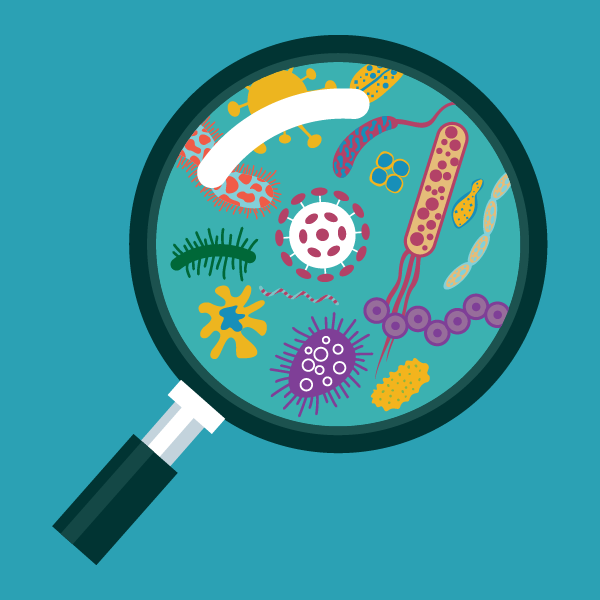Design your own bacteria!

Cartoon bacteria through a magnifying glass (sorbetto, Getty Images)

Cartoon bacteria through a magnifying glass (sorbetto, Getty Images)
How does this align with my curriculum?
How could you design a new type of bacteria that helps people?
Consider using the Design & Build Process with this challenge.
This activity will help build skills related to the Identify the Problem, Research, Generate Ideas, Plan, and Reflect & Share phases of this process.
Materials:
- Paper and writing/drawing tools (e.g., pencils, coloured pencils, markers)
or
- A device with a digital drawing program
What to do!
Imagine you are a research scientist working with bacteria. Your task is to design a new bacterium that can help humans in some way.
- Identify the Problem - Think about what you want your bacteria to do. How will it help people?
- Research - You might want to read the following articles about bacteria, including Introduction to Bacteria, Colouring Clothing with Bacteria, and Plastic-Eating Bacteria: Nature's Recyclers to get an idea of some different aspects and functions of bacteria.
- Generate Ideas - What kind of body parts might it need? What might it need for protection? What might it need to survive in its environment?
- Plan – Which ideas are your best? How will you show people what your bacteria might look like?
- Reflect & Share - Design your bacteria and share it with others.
Discovery
Bacteria are all around. They can be found almost everywhere! Bacteria are very good at adapting to new environments. That’s partly because they can reproduce so quickly. For example, E. coli can double its population every 20 minutes! Each time an organism reproduces, there is a chance its DNA will change. These changes are called mutations. Sometimes mutations help bacteria to survive. If one bacterium has a helpful mutation, other bacteria may develop it too. In one day, you could have a whole population that can now survive in a new environment. Compare that to humans. It would take many children and many years to spread a mutation in a human population.
This is why bacteria have so many different functions and abilities. This is also why we need to keep making new antibiotics. Bacteria can quickly evolve to become resistant to them! This is where the term drug-resistant bacteria comes from. People can help by only taking antibiotics when they really need them.
Some bacteria can harm us, and some bacteria can help us. We use bacteria to make different foods, dye clothing, and break down plastics. And there are so many other things bacteria can do!
Have you ever seen the terms probiotics or prebiotics on food packages? Those are foods that help maintain the “good” bacteria in your body to help keep you healthy! There are many “good” bacteria in our bodies that help protect us against “bad” ones.
- Create a 3D model of your bacterium.
- Do bacteria like yours exist in real life? Find out!
- How else do people use bacteria?
What’s happening?
Bacteria are all around. They can be found almost everywhere! Bacteria are very good at adapting to new environments. That’s partly because they can reproduce so quickly. For example, E. coli can double its population every 20 minutes! Each time an organism reproduces, there is a chance its DNA will change. These changes are called mutations. Sometimes mutations help bacteria to survive. If one bacterium has a helpful mutation, other bacteria may develop it too. In one day, you could have a whole population that can now survive in a new environment. Compare that to humans. It would take many children and many years to spread a mutation in a human population.
This is why bacteria have so many different functions and abilities. This is also why we need to keep making new antibiotics. Bacteria can quickly evolve to become resistant to them! This is where the term drug-resistant bacteria comes from. People can help by only taking antibiotics when they really need them.
Why does it matter?
Some bacteria can harm us, and some bacteria can help us. We use bacteria to make different foods, dye clothing, and break down plastics. And there are so many other things bacteria can do!
Have you ever seen the terms probiotics or prebiotics on food packages? Those are foods that help maintain the “good” bacteria in your body to help keep you healthy! There are many “good” bacteria in our bodies that help protect us against “bad” ones.
Investigate further!
- Create a 3D model of your bacterium.
- Do bacteria like yours exist in real life? Find out!
- How else do people use bacteria?